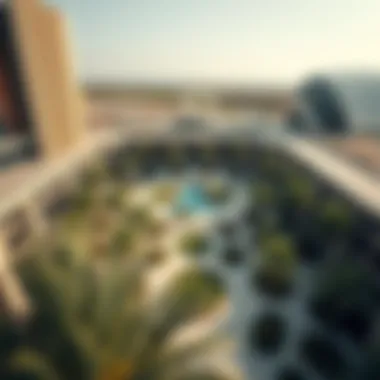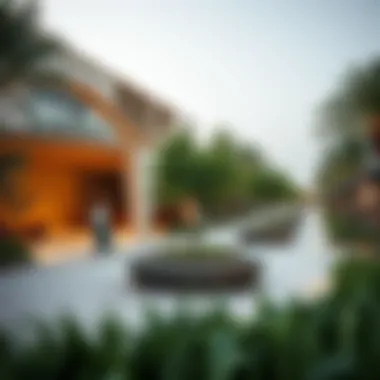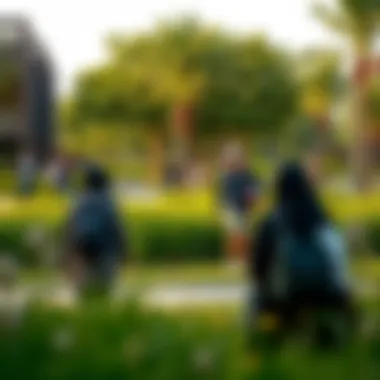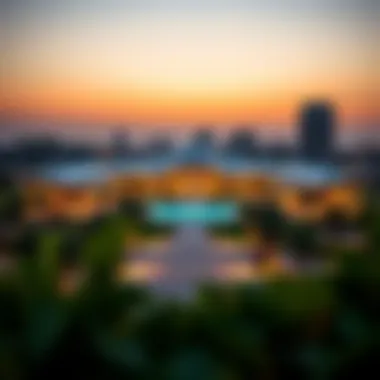Royal Park: Innovation and Sustainability in Masdar City


Intro
Situated at the heart of Masdar City, Royal Park emerges as a vibrant symbol of harmony between urban development and nature. This unique space offers a glimpse into a future where ecological sustainability and urban living coexist, paving the way for innovative lifestyles. The park spans a significant area, filled with lush greenery and state-of-the-art facilities designed to foster community engagement and ecological awareness.
As we explore the nuances of Royal Park, it's important to understand its significance within the larger context of Dubai's real estate landscape. The park not only serves as a picturesque recreational area but also as a blueprint for sustainable urbanization in the Middle East. In a city where rapid development often challenges ecological balance, Royal Park stands out as a testament to visionary planning and execution.
We shall delve into several aspects of this unique park, covering its design philosophy, ecological impact, and community involvement. Furthermore, we will assess how it shapes the expectations and actions of real estate investors, homeowners, and urban planners alike. Ultimately, this article aims to offer a comprehensive overview of Royal Park, shedding light on its role as a model for future developments in urban environments.
Preface to Masdar City and Royal Park
Masdar City represents more than just a place on the map—it's a pioneering initiative aimed at creating one of the smartest, most sustainable urban environments on the globe. Located in the United Arab Emirates, this city reflects a commitment to sustainability woven into the fabric of urban living. It's crucial to understand this context as we delve into the significance of Royal Park, which serves as a cornerstone in this visionary landscape.
The planning and development of Masdar City began in earnest to address increasing urbanization and its accompanying challenges like resource depletion and environmental degradation. As a green urban development, it combines cutting-edge technologies with traditional practices, making it a living laboratory for innovators and thinkers striving for a balanced coexistence with nature. Incorporating elements such as renewable energy and revolutionary waste management systems, Masdar City sets the standard for future urban developments.
Background of Masdar City
Masdar City is often referred to as a blueprint for future cities. The vision was initiated by the Abu Dhabi government in 2006, aiming to create a zero-carbon, zero-waste urban development that uses sustainable energy sources. Planners designed the city with a compact layout, aiming to minimize transportation needs and maximize efficiency.
Comprising various sectors—from residential areas to offices and research centers—Masdar City thrives on innovation and adaptability. The current layout ensures that facilities are in close proximity, promoting walking and cycling. This mix of residential, commercial, and educational spaces encourages a community-oriented lifestyle.
In addition to promoting ecological sustainability, Masdar City is also an incubator for green technologies, hosting various start-ups and established companies in search of innovative solutions for urban challenges. Given its strategic location, both investors and real estate professionals have taken note of Masdar City as a hub for futuristic living and sustainable building solutions.
Significance of Royal Park
Within Masdar City, Royal Park plays an indispensable role. It isn’t merely a green space but a vital contributor to the holistic vision of urban living in harmony with nature. Its presence underscores the commitment to creating an inclusive community where residents can enjoy not only the benefits of greenery but also the myriad of opportunities it provides.
Royal Park goes beyond bein a picturesque environment. It actively promotes eco-friendly practices. The park implements various features aimed at enhancing sustainability—think natural water irrigation systems and native plant species that require minimal resources to thrive. This thoughtful approach not only helps maintain local biodiversity but serves as an educational tool for residents, illustrating the importance of resource conservation.
Moreover, having a dedicated space for leisure and recreation improves overall well-being. Royal Park fosters social interactions by providing areas for community gatherings, outdoor events, and educational programs. It is this blend of ecological and social functions that positions Royal Park as a vital piece of the Masdar City puzzle.
"Sustainability isn’t just a trend; it’s the future of urban development. Royal Park exemplifies how nature and innovation can coexist beautifully.”
For further insights into the principles of sustainable city planning, you may explore resources such as Wikipedia or Britannica. Whether you’re an investor eyeing new opportunities or a developer seeking inspiration, the journey through Masdar City and its Royal Park promises vast potential.
Design Philosophy and Architectural Features of Royal Park
The design philosophy behind Royal Park is vital to understanding its role in Masdar City as a significant urban space fostering biodiversity and community engagement. It's not just about tree-lined paths or pretty flower beds; it’s the holistic approach that makes this park a model for urban sustainability. The architectural features of Royal Park reflect a deep recognition that urban areas must coexist with nature, advocating for a lifestyle that respects the environment while providing a pleasant living experience.
Incorporating Nature into Urban Planning


Integrating nature into urban planning has become not just a trend, but a necessity. Royal Park’s design encapsulates this ethos, creating a retreat from the urban hustle and bustle. The park includes walking trails, shaded seating areas, and community gardens that promote interaction among residents. A particular focus is given to native plants, reducing water usage while also providing a habitat for local wildlife. Not only does this approach enhance the aesthetic appeal, it also serves a deeper ecological purpose.
"In urban areas, parks are the lungs of the city, providing a breath of fresh air both literally and figuratively."
Furthermore, the incorporation of green roofs and vertical gardens not only beautifies buildings but also contributes to air quality. The park’s layout encourages biodiversity, allowing a variety of flora and fauna to thrive amidst urban development. This careful planning showcases that by embedding natural elements into urban spaces, cities can become more resilient and adaptive.
Sustainable Materials and Techniques
The architectural integrity of Royal Park embodies sustainability, utilizing innovative materials and techniques tailored to the local environment. Materials sourced locally minimize the carbon footprint, ensuring that the park reflects the character of Masdar City. For instance, stone and timber used in park facilities are chosen not just for aesthetics but for their long-term durability and minimal environmental impact.
Furthermore, the use of recycled materials in pathways minimizes waste and promotes reuse. Features such as solar-powered lighting and rainwater harvesting systems demonstrate a commitment to sustainability. These elements show the balance between modern technology and eco-friendly practices, providing a platform for sustainable urban living.
Integration with Surrounding Environments
The integration of Royal Park into its surroundings is a quintessential aspect of its design philosophy. Positioned strategically within Masdar City, the park connects major residential and commercial zones, promoting pedestrian traffic and reducing reliance on vehicles. The seamless flow from urban areas into the park offers a natural transition that enhances accessibility and invites residents to engage with their environment.
Landscaping also plays a critical role in integration. To transition the urban landscape into the park, natural contours and varied plant heights are used. They not only create picturesque views but also act as barriers against noise and dust, improving the quality of life for residents nearby. This attention to detail reaffirms Royal Park’s ambition: to create an oasis within an innovative urban center, weaving nature into the fabric of city life.
As we delve deeper into Royal Park, the architectural features and design philosophies become not merely about visual appeal; they are part of a broader narrative about sustainability and community. Each aspect, from materials to layouts, contributes to a park that stands as a model for future urban developments, balancing the needs of people with those of the planet.
Ecological Impact of the Park
The ecological impact of Royal Park in Masdar City transcends mere aesthetics; it plays a vital role in enhancing environmental health and sustainability in urban settings. As cities continue to grow at an exponential rate, integrating green spaces like Royal Park becomes essential. Not only does it contribute to beautification, but it also addresses critical ecological issues, making it a blueprint for future urban developments worldwide. The park’s design considers myriad elements aimed at fostering nature's revival within a concrete jungle, contributing to long-term ecological resilience.
Promoting Biodiversity
Biodiversity is the lifeblood of any ecosystem, and Royal Park is a prime example of how urban areas can foster it. The park incorporates native plants, which are better adapted to the local climate and require less water, providing a habitat for local fauna. This initiative aids in creating a balanced ecosystem where insects, birds, and even small mammals can thrive.
Moreover, creating diverse plant communities helps in creating microhabitats that attract various species. For instance, a section of the park dedicated to wildflowers provides a crucial breeding ground for pollinators, thereby enhancing the overall health of the ecosystem. Such a focus not only contributes to biodiversity but also mitigates the environmental impact of urbanization by restoring natural habitats that urban development often disrupts.
"A city without parks is like a heart without a beat; it needs green lungs to breathe."
Water Conservation Initiatives
Water scarcity poses a significant challenge for many urban environments, especially in arid regions like the UAE. Royal Park features innovative water conservation initiatives designed to optimize water use without sacrificing the park’s lush landscape. One of these strategies includes the use of smart irrigation systems that respond to the weather conditions, ensuring that plants receive just the right amount of water.
Additionally, the park employs rainwater harvesting systems. This not only reduces dependence on municipal water sources but also promotes sustainability. The captured rainwater is directed to irrigation systems, thereby minimizing waste and utilizing natural resources effectively. Another significant aspect is the incorporation of wetlands within the park, which not only aids in water filtration but also provides habitats for various aquatic species.
Reducing Urban Heat Island Effect
The urban heat island effect is a common phenomenon where city environments experience significantly higher temperatures than surrounding rural areas due to human activities and infrastructure. Royal Park aims to combat this effect by implementing several green design elements.


The extensive tree canopies throughout the park provide natural shade, which lowers surface temperatures not just within the park but also in adjacent urban areas. Materials used in pathways and buildings are chosen for their reflective properties, helping to mitigate heat absorption, which points to a thoughtful approach in material selection.
Moreover, the park's green roofs and vertical gardens contribute to temperature regulation, further enhancing the cooling effect. This way, Royal Park serves not only as a green space for recreation but also as an example of how integrating nature into urban environments can lead to significant cooling benefits—a critical feature for cities grappling with the realities of climate change.
By prioritizing ecological impact, Royal Park stands as a leading example of how urban parks can support sustainability, enthralling investors, developers, and residents alike.
Community Engagement and Social Benefits
Community engagement plays a pivotal role in the success of urban developments like Royal Park in Masdar City. It fosters a sense of belonging and ownership among residents while enhancing the social dynamics of the park. The active involvement of the community not only reflects their needs and aspirations but also nurtures an environment conducive for sustainable living. By creating spaces that resonate with the values of local inhabitants, developers can expect both environmental and social dividends.
One of the primary benefits of community engagement is the enhanced social cohesion it brings. When residents partake in planning and decision-making processes, they contribute their insights and preferences, ensuring that the park serves diverse interests. This collaborative approach breeds a sense of pride and responsibility toward the park, encouraging more people to utilize and maintain communal spaces. Furthermore, such involvement invariably leads to more tailored solutions that reflect the unique cultural landscape of the locality.
Involvement of Local Residents in Planning
In Royal Park, involving local residents during the planning stages was crucial. It aligned the park’s development with the needs, cultural values, and climatic realities of the region. Community workshops and surveys became platforms for individuals to voice their thoughts on what they wished to see.
- Feedback Mechanism: Various feedback loops were established, allowing in-depth discussions on potential features, such as play areas, community gardens, and recreational zones.
- Cultural Considerations: Integrating elements that reflect local traditions and aesthetics has been a priority. For instance, the introduction of shaded areas and water features not only caters to the weather conditions but also aligns with the traditional outdoor lifestyles of the residents.
This level of involvement ensures that the end product isn’t a mere blueprint of urban standards but a reflection of the community’s heart and soul.
Events and Activities within Royal Park
Royal Park is not just an expanse of greenery but a lively hub filled with activities that promote engagement and interaction. Events organized within the park play a crucial role in bringing people together, often serving as a bridge between different cultures and generations.
- Seasonal Festivals: These events celebrate local culture, allowing residents to showcase their heritage through arts, crafts, and cuisine.
- Wellness Programs: Activities focused on promoting health, such as yoga sessions and group workouts, encourage residents to adopt a fitting lifestyle while fostering camaraderie among participants.
- Educational Workshops: These sessions cover a range of topics, from sustainability practices to art classes, providing hands-on experience and understanding of relevant issues.
By hosting diverse events, Royal Park strengthens community bonds while empowering individuals to take an active part in shaping their environment.
Creating a Sense of Community
The essence of any successful urban park lies in its ability to create a genuine sense of community among its users. Royal Park effectively achieves this through thoughtful design and programming that draws individuals out of their homes and into shared spaces.
- Social Spaces: The layout includes communal areas that facilitate gatherings and interactions, further encouraging relationships among neighbors.
- Volunteer Opportunities: Initiatives that invite residents to partake in maintaining the park not only beautify the area but also instill a sense of pride and responsibility.
- Community Boards: These serve as channels for sharing local events, announcements, and initiatives, keeping everyone in the loop and solidifying connections.
"A community that blooms together thrives together.”
By making Royal Park a canvas for social interaction, it transforms not just the physical space, but the way people connect, collaborate, and celebrate life. In a world where isolation can be the norm, this park acts as a beacon for unity and purpose, solidifying its role in the heart of Masdar City.
Future Prospects and Challenges


As urban areas continue to expand, the challenge of creating sustainable living environments becomes more complex. Royal Park is central to the ambitions of Masdar City, offering a glimpse into how modern urban design can harmonize with nature. Understanding the future prospects for Royal Park, alongside the challenges it faces, is essential for stakeholders including investors, real estate agents, and developers. After all, this park represents the future of ecological balance in urban settings and is a testing ground for innovative ideas in sustainability.
Expansion Plans and New Initiatives
The expansion plans for Royal Park are ambitious and multifaceted. Local authorities and developers envision a park that not only enhances biodiversity but also integrates more seamlessly with the surrounding urban landscape. There are plans for new pathways, additional green spaces, and the installation of smart technology that prioritizes energy efficiency. This includes:
- Enhanced connectivity to public transit, making it easier for residents and visitors to access the park.
- New recreational areas, including playgrounds and community gardens, aimed at fostering interaction among residents.
- Educational installations that will promote environmental awareness through interactive exhibits.
Each of these initiatives is designed to draw more people to Royal Park, encouraging a sense of community and promoting sustainability as a lifestyle. These developments are not merely aesthetic; they aim to attract investments from green technology firms and eco-conscious businesses, ultimately bolstering the local economy. As the park grows, it becomes a viable model for other urban areas facing similar development pressures.
Addressing Climate Change and Urban Growth
In today’s context, addressing climate change in urban growth is non-negotiable. Royal Park is at the frontline of this mission, leveraging innovative strategies to mitigate environmental impacts while promoting a livable city. Measures being adopted include:
- Green roofs and walls on nearby buildings that enhance insulation, reduce heat emission, and foster urban wildlife.
- Stormwater management systems designed to capture and recycle rainwater, effectively managing runoff and conserving water.
- Use of renewable energy sources, like solar panels integrated throughout the park, which power facilities and amenities, diminishing reliance on non-renewable resources.
These initiatives not only cater to ecological considerations but also allow urban planners to respond effectively to climate challenges. By positioning Royal Park as a vanguard of sustainable practices, it sets a benchmark for how urban developments can adapt to and mitigate the challenges posed by climate change.
"Royal Park embodies the potential of eco-friendly urbanization, where innovation meets sustainability to prepare for future environmental challenges."
Overall, the future of Royal Park is tied not just to its physical expansion, but to its role as a catalyst for broader urban change. The strategies employed here can guide the development of other cities facing similar environmental concerns. Through thoughtful planning and engagement, Royal Park may become a definitive example of how urban spaces can evolve to meet the demands of a dynamic and unpredictable climate.
The End: The Role of Royal Park in Urban Sustainability
The significance of Royal Park in the landscape of urban sustainability cannot be overstated. As a central element within Masdar City, it embodies a wide range of ecological, social, and economic benefits that contribute to the overall vision of sustainable urban living. The park serves as a critical reminder of how cities can nurture nature while promoting innovative development. This dual role of protecting the environment and enhancing urban life positions Royal Park as a key player in tackling pressing challenges faced by contemporary urban environments.
The Vision for Future Urban Parks in Dubai
As Dubai continues to undergo rapid urbanization, the need for thoughtful and sustainable parks becomes increasingly important. The vision behind future urban parks is centered around creating multifunctional spaces that cater to both residents and visitors. The aspiration for parks like Royal Park is to integrate green spaces seamlessly into the urban fabric, contributing not just aesthetically, but also enhancing community well-being.
Urban parks of tomorrow might incorporate:
- Smart technology: Utilizing technology for resource management, such as automation in irrigation systems or solar lighting, optimizing both energy consumption and maintenance costs.
- Cultural hubs: Establishing areas for art installations, performance spaces, and community events that resonate with the cultural heritage of the region, ensuring that parks are not just recreational spaces but also sites for social interaction and cultural expression.
- Accessibility: Focusing on inclusivity by ensuring that all citizens, regardless of ability, can enjoy the benefits of green spaces.
By embracing these elements, Dubai can create urban parks that are alive with activity and are integral to the city's identity.
Royal Park as a Model for Global Cities
Beyond its immediate geographical context, Royal Park offers valuable insights for cities worldwide. The thoughtful integration of nature within urban spaces presents a blueprint for how urban planning can evolve. Many cities grapple with issues like pollution, overcrowding, and a lack of green zones. Royal Park exemplifies the benefits of urban greening, which can lead to enhanced air quality, improved mental health, and greater community engagement.
The lessons learned from Royal Park might include:
- Holistic planning strategies that incorporate environment and community feedback from the get-go.
- Sustainable practices that other cities can adopt, such as water conservation methods or the use of native plants that require less maintenance and support local wildlife.
- Collaboration with stakeholders, including local governments, private developers, and the community, to ensure that the needs of all parties are met, fostering shared ownership and care for the parks.
"Royal Park stands as a testament to the success of blending urban life with nature, offering a viable path for cities navigating the complexities of modern growth."
Ultimately, Royal Park reaffirms the crucial connection between nature and urban life, illuminating a trail for other cities to follow. As more urban areas grapple with environmental issues, the vision set forth by Royal Park may serve not just as a local inspiration but as a global model for a sustainable future.











